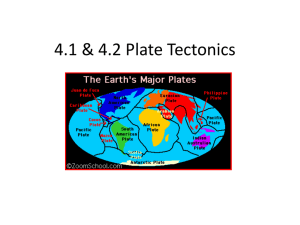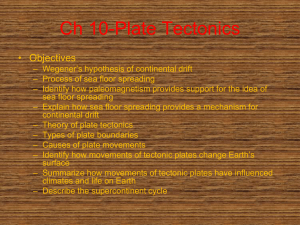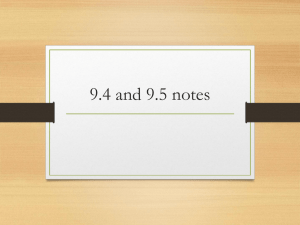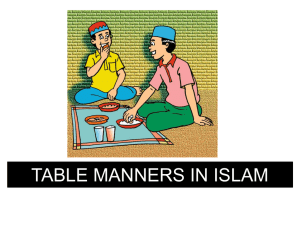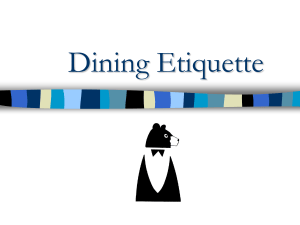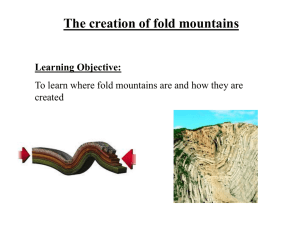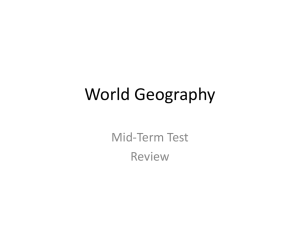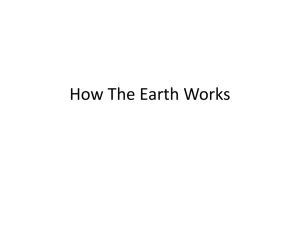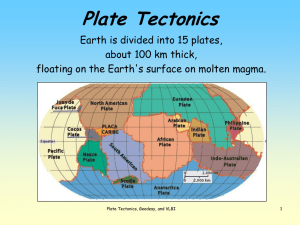theory of Plate Tectonics ppt
advertisement
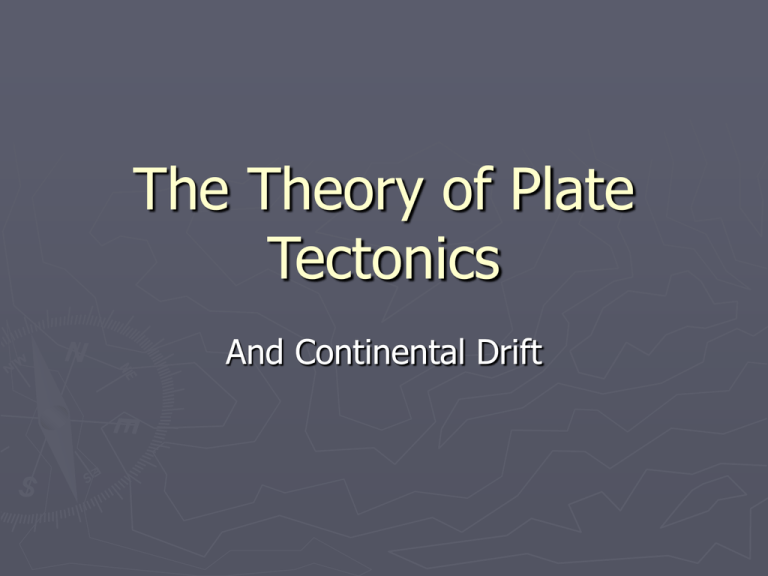
The Theory of Plate Tectonics And Continental Drift Essential Questions ► What is the Theory of Continental Drift? ► What is the Theory of Plate Tectonics? ► What are the names of the plates? Practical Exercise 1 Supercontinents! ► If you look at a map of the world, you may notice that some of the continents could fit together like pieces of a puzzle. The Birth of a Theory Earth Revealed Series ► While watching the video, complete the worksheet provided. This is to be put into your portfolio. ► http://www.learner.org/vod/vod_window.ht ml?pid=316 ► 19 mins Global Tectonics: Competing Theories ► While watching the video, complete the worksheet provided. This is to be placed into your portfolio. ► http://learning.aliant.net/Player/ALC_Player. asp?ProgID=VEA_TECTONICS ► 22 mins Global Tectonics: Competing Theories ► After the video, answer the “after the program” questions. These are due in 1 week. The Development of the Theory Wegener’s continental drift hypothesis stated that the continents had once been joined to form a single supercontinent. Wegener proposed that the supercontinent, Pangaea, began to break apart 200 million years ago and form the present landmasses. Wegner proposed this theory in 1912 Breakup of Pangaea Continental Drift Evidence The Continental Puzzle Matching Fossils Fossil evidence for continental drift includes several fossil organisms found on different • landmasses. Rock Types and Structures Rock evidence for continental exists in the form of several mountain belts that end at one coastline, only to reappear on a landmass across the ocean. Ancient Climates Problems With Wegener’s Theory ► No mechanism for movement of continents ► Wind and currents could possibly move fossils ► Theory was not accepted by scientists Continental Drift continued A New Theory Emerges Wegener could not provide an explanation of exactly what made the continents move. New technology lead to findings which then lead to a new theory called plate tectonics. Testing Plate Tectonics Evidence for Plate Tectonics Paleomagnetism is the natural remnant magnetism in rock bodies; this permanent magnetization acquired by rock can be used to determine the location of the magnetic poles at the time the rock became magnetized. Normal polarity—when rocks show the same magnetism as the present magnetism field Reverse polarity—when rocks show the opposite magnetism as the present magnetism field The discovery of strips of alternating polarity, which lie as mirror images across the ocean ridges, is among the strongest evidence of seafloor spreading. Testing Plate Tectonics continued Earthquake Patterns Scientists found a close link between deep-focus earthquakes and ocean trenches. The absence of deep-focus earthquakes along the oceanic ridge system was shown to be consistent with the new theory. Ocean Drilling The data on the ages of seafloor sediment confirmed what the seafloor spreading hypothesis predicted. The youngest oceanic crust is at the ridge crest, and the oldest oceanic crust is at the continental margins. Hot Spots A hot spot is a concentration of heat in the mantle capable of producing magma, which rises to Earth’s surface; The Pacific plate moves over a hot spot, producing the Hawaiian Islands. Hot spot evidence supports that the plates move over the Earth’s surface. Time to Pause… ► Plate Tectonics Theory assignment. ► Tectonics From the Greek tekton, meaning “builder” The general term used to describe mountain building, volcanism, and other processes that construct geologic features Ben Franklin, 1782 ► Such changes in the superficial parts of the globe seemed to me unlikely to happen if the Earth were solid to the center. I therefore imagined that the internal parts might be a fluid more dense, and of greater specific gravity than any of the solids we are acquainted with, which therefore might swim in or upon the fluid. Thus the surface of the Earth would be a shell, capable of being broken and disordered by the violent movements of the fluid on which it rested. Plate Tectonics ► The Earth’s crust is divided into plates which move in various directions. ► This plate motion causes them to collide, pull apart, or scrape against each other. ► Each type of interaction causes a characteristic set of Earth structures or “tectonic” features. ► The word, tectonic, refers to the deformation of the crust as a consequence of plate interaction. World Plates Major Plates ► North American Plate covering most of North America, Greenland, Cuba, Bahamas, and parts of Siberia and Iceland. It extends eastward to the Mid-Atlantic Ridge and westward to the Chersky Range in eastern Siberia. ► Eurasian Plate covering most of North America, Greenland, Cuba, Bahamas, and parts of Siberia and Iceland. It extends eastward to the Mid-Atlantic Ridge and westward to the Chersky Range in eastern Siberia. ► Pacific Plate is an oceanic tectonic plate beneath the Pacific Ocean at 103 million square kilometres it is the largest of all tectonic plates Major Plates continued… ► South American Plate includes the continent of South America and also a sizeable region of the Atlantic Ocean seabed extending eastward to the Mid-Atlantic Ridge. ► Antarctic Plate includes the continent of Antarctica and extending outward under the surrounding oceans. ► Australian Plate includes the continent of Australia and surrounding ocean, and extends northwest to include the Indian subcontinent and adjacent waters. ► African Plate includes the continent of Africa, as well as oceanic crust which lies between the continent and various surrounding ocean ridges. Minor Plates ► Nazca Plate an oceanic tectonic plate in the eastern Pacific Ocean basin off the west coast of South America. ► Carribean Plate mostly oceanic tectonic plate underlying Central America and the Caribbean Sea off the north coast of South America. ► Cocos Plate is an oceanic tectonic plate beneath the Pacific Ocean off the west coast of Central America ► Juan de Fuca Plate generated from the Juan de Fuca Ridge Minor Plates continued… ► Arabian Plate consists mostly of the Arabian peninsula; it extends northward to Turkey. ► Indian Plate includes the subcontinent of India and a portion of the basin under the Indian Ocean ► Philippine Plate comprising most of the country of the Philippines. ► Scotia Plate an oceanic tectonic plate Time to Pause… ► Complete Names the worksheet – Tectonic Plate What are tectonic plates made of? ► Plates are made of rigid lithosphere. The lithosphere is made up of the crust and the upper part of the mantle. Plate Movement ► “Plates” of lithosphere are moved around by the underlying hot mantle convection cells How can Earth’s plates move? ► The plates of the lithosphere float on the top of the asthenosphere ► Convection currents rise in the asthenosphere and spread out beneath the lithosphere ►Geologists believe this causes plate movement Practical Exercise 2 Where will “x” be in: 1,000 years? 1,000,000 years? 1,000,000,000 years?
